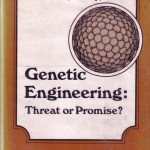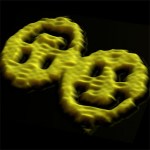DNA
All of our cells are staffed by armies of executioners. They are usually restrained but when unleashed, they can set off a fatal chain reaction that kills the cell. This suicide squad does away with billions of cells every day. It helps to balance the production of new cells with the loss of old ones, to sculpt growing tissues and to destroy potential cancer cells.
But a new study suggests that the executioners aren't always lethal. In fact, they're essential for life. Through the unorthodox method of damaging our DNA, they can actually activate important genes. This technique for switching…
Meet "Inuk". He is the ninth human to have their entire genome sequenced but unlike the previous eight, he has been dead for some 4,000 years old. Even so, DNA samples from a tuft of his frozen hair have revealed much about his appearance and his ancestry.
Inuk had brown eyes and brown skin. His blood type was A+. His hair was thick and dark but had he lived, he might not have kept it - his genes reveal a high risk of baldness. Inuk may well have died quite young. Like many Asians and Native Americans, his front teeth were "shovel-graded", meaning that their back faces had ridged sides and…
Awful Library Books has a post on books about genetic engineering from the 1970's and 80's, saying that it's time to get rid of them because "Genetic information is dramatically different from what we knew in the 70's and 80's. No mention of Human Genome Project or Dolly, the sheep." If you're looking for information about cutting-edge genetic engineering you're probably better off not looking for a book at all, but while science is inherently focused on the future, a historical perspective is almost always valuable, especially when it comes to genetic engineering and synthetic biology.
The…
Most synthetic biologists and biological engineers (and basically everyone else) think of DNA as code, simply carrying the information to make the RNA and proteins that do the real work inside the cell. In the past few years, a small group of biological engineers have used DNA instead as a physical substrate, a programmable nanomaterial to build all kinds of tiny shapes with (even smiley faces). The shapes that the DNA folds into depend on the sequence, which controls how different strands match up to each other and bend. For a great introduction to building shapes out of DNA in 2D and 3D…
If you've ever put a pair of headphones in your pocket, you'll know how difficult it is to keep a long cord in a bundle without getting it hopelessly tangled and knotted. You'll also start to appreciate the monumental challenge that our cells face when packaging our DNA. At 2 metres in length, the human genome is longer than the average human but it needs to be packaged inside the nucleus of every one of our cells, each just 6 millionths of a metre long. How does it do it?
One of the secrets behind this monumental feat of folding has just been revealed by research that reveal's the human…
DNA is most famous as a store of genetic information, but Shawn Douglas from the Dana-Farber Cancer has found a way to turn this all-important molecule into the equivalent of sculptor's clay. Using a set of specially constructed DNA strands, his team has fashioned a series of miniscule sculptures, each just 20-40 nanometres in size. He has even sculpted works that assemble from smaller pieces, including a stunning icosahedron - a 20-sided three-dimensional cage, built from three merged parts.
Douglas's method has more in common with block-sculpting that a mere metaphor. Sculptors will often…
Nocturnal animals face an obvious challenge: collecting enough light to see clearly in the dark. We know about many of their tricks. They have bigger eyes and wider pupils. They have a reflective layer behind their retina called the tapetum, which reflects any light that passes through back onto it. Their retinas are loaded with rod cells, which are more light-sensitive than the cone cells that allow for colour vision.
But they also have another, far less obvious adaptation - their rod cells pack their DNA in a special way that turns the nucleus of each cell into a light-collecting lens.…
This photo was ultimately rejected for a journal cover (it was the wrong shape!) but I shot it to accompany a research article that used museum specimens of midwestern bumblebees to compare current levels of genetic diversity with previous decades. Since this image won't appear in print anytime soon, I thought I'd share it here instead.
photo details: Canon 35mm f2.0 prime lens on a Canon EOS 20D
ISO 200, 1/125 sec, f/5, indirect strobe
Some people, like Imelda Marcos and our new Dr. Isis, have a thing for fancy shoes.
I go crazy for gadgets.
technorati tags: iphone, DNA, molecules, molecular structure, molecular modeling, Science education
For my birthday this year, my family bought me a new iPhone! Yeah!
So, I've been killing several hours today filling it with cute little iPhone apps. Who knew one little phone could be so much fun?
One app, I enjoy, is called Molecules.
Molecules lets you download structure files from the Protein Data Bank (PDB) and play with the structures on your phone!
Spreading your fingers…
From the well-preserved remains of a woolly mammoth that was buried by Siberian winters about 18,545 years ago, scientists were able to extract viable DNA and sequence the majority of an extinct species' genome for the first time. The mammoth's genome is currently about 70 percent sequenced, and researchers estimate the size of the genome to be 40 percent larger than the human genome—approximately the same size as the modern day elephant, which scientists could theoretically use to birth a cloned anachronistic creature.
Chemistry spans orders of magnitude in terms of polarity. Many of the organic guys who read this work on stuff that never would dissolve in water (which becomes something of a pain when you try and make that something into a drug for aqueous things like people). And the biologists work on stuff that would just maybe dissolve in DMSO, but not even methanol, otherwise. Polarity defines chemistry. I know techniques that will help me isolate gobs of biomolecules out of water, and gobs of organic molecules out of ether. It's that intermediate, medium solubility stuff that's a pain!
Propidium is a…
I got my copy of "A short guide to the human genome" by Stewart Scherer today from Cold Spring Harbor Laboratory Press (2008, ISBN 978-087969791-4). Usually, I would wait until after I've read a book to write a review, but this book doesn't require that kind of study. As soon I skimmed through it and read some of the questions and answers, I knew this would be the kind of quick reference that I would like to have sitting above my desk.
Scherer has compiled a wonderful text that not only answers many of the kinds of questions that I can think to ask about the human genome, but the kinds of…
Believe it or not, this is a DNA kiss.
Have a loverly Valentine's DNA!
(And just in case you're wondering, yes, I did put it on a coffee mug.)
tags: researchblogging.org, evolution, bird-dinosaur split, dinosaurs, birds, rocks-versus-clocks, fossil record, molecular clocks
The first feathered dinosaur fossil found in China -- Sinosauropteryx.
The feathers can be seen in the dark line running along the specimen's back.
Image: Mick Ellison, AMNH [larger view]
There is a lot of controversy among scientists regarding when modern birds first appeared. The current fossil record suggests that modern birds appeared approximately 60-65 million years ago when the other lineages of dinosaurs (along with at least half of all terrestrial…
tags: Deroptyus accipitrinus, hawk-headed parrot, red-fan parrot, pets, birds, avian, parrots
Adult red fan (hawk-headed) parrot, Deroptyus a. accipitrinus.
(Adults of both sexes are distinguished from juveniles
by the creamy white spot on the forehead
and the orange ring around the pupil of the eye.
The skin around the eye darkens in adults if
the birds are exposed to sunlight).
Image: Dale R. Thompson.
As you probably remember, about six weeks ago, a reader got me a young, newly-weaned hawk-headed parrot, Deroptyus a. accipitrinus, for a pet. I preferred not to name this bird until…
Most metal ions will coordinate some electron-rich species in solution - water is a common suspect. Many other things can be hung off of certain metals, however, and an entire field and fame and fortune are available to those who manage to make something useful involving a metal. "Inorganic chemistry" is really a field unto itself - organic and biochemists make use of it, but we don't really understand it.
To that end, here's something we use to condense DNA. Cobalt (III) hexamine, or Co(NH3)63+. It actually hangs onto six molecules of ammonia, and they're "exchange inert" - you can put the…
Last year I wrote about an experiment where I compared a human mitochondrial DNA sequence to primate sequences in the GenBank. Since I wanted to know about the differences between humans, gorillas, and chimps, I used the Entrez query 'Great Apes' to limit my search to a set of sequences in the PopSet database that contained gorillas, bonobos, chimps, and human DNA.
A week ago, I tried to repeat this experiment and...
It didn't work.
All I saw were human mitochondrial sequences. I know the other sequences match, but I didn't see them since there are so many human sequences that…
One of my readers asked: Why does genome sequencing cost so much?
My short answer is because it's big.
But I thought it would be fun to give a better answer to this question, especially since I'm sure many of you are wondering the same thing.
Okay, so let's do some math.
Don't worry, this math isn't very complicated and I'll explain where most of the numbers come from.
Estimating costs from salaries
First, we'll take the easy route. My experience with grant budgets has taught me that the greatest cost for any project comes from salaries. If we look at the PLoS paper with Craig Venter's…
If you've read any of the many stories lately about Craig Venter or Jim Watson's genome, you've probably seen a "SNP" appear somewhere. (If you haven't read any of the stories, CNN has one here, and my fellow bloggers have posted several here, here, here, here, here, and here.)
You may be wondering, and rightly so: just what is a SNP?
Never fear, hopefully this post will answer some of those questions.
tags: DNA sequencing, DNA , SNPs, genetic testing
SNP stands for Single Nucleotide Polymorphism. That's a mouthful. It means some people, will have one base at a certain position, in a…
The phosphoramidite method of oligonucleotide synthesis has been invaluable. WIth a few reagents and an expensive machine, you can make any sequence of DNA or RNA. Purification can be a bit tricky, and it only gets worse as you get longer (once you're up to about 100 bases, you probably have a third or less of your desired stuff, the rest is shorter, truncated strands). That said, it's pretty amazing - making a strand of DNA or RNA is as simple as spelling it out.
Oligos are important! The polymerase chain reaction needs two of them. Companies have been set up exclusively to sell them. Can…

